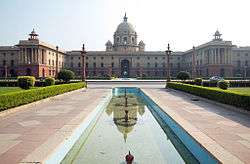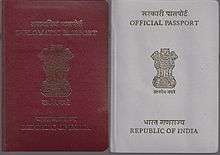Indian Foreign Service
| Service Overview | |
|---|---|
| Formed | October 9, 1946 |
| Headquarters | South Block, New Delhi |
| Country |
|
| Training Ground | Foreign Service Institute, New Delhi |
| Field of Operation |
|
| Controlling Authority | Ministry of External Affairs |
| Legal personality | Governmental: Government Services |
| General Nature |
Diplomacy & Foreign policy Economic diplomacy Trade Relations Defence Diplomacy Cultural diplomacy Consular Services Public diplomacy Intergovernmental organization |
| Preceding Service | Indian Civil Service |
| Cadre Size |
1750 posts (2013)[1] (Group A - 750; Group B - 250)[1] |
| Service Chief | |
| Foreign Secretary | Subrahmanyam Jaishankar (Incumbent) |
| Head of the All India Civil Services | |
| Current Cabinet Secretary | Pradeep Kumar Sinha, IAS |
The Indian Foreign Service (Hindi: भारतीय विदेश सेवा) is the administrative diplomatic[2] civil service under Group A[3] and Group B[4] of the Central Civil Services of the executive branch of the Government of India. It is one of the two premier Civil Services (other being IAS), as appointment to IFS renders a person ineligible to reappear in Civil Services Examination.[5] It is a Central Civil service as Foreign policy is the subject matter and prerogative of Union Government.[6] The Ambassador, High Commissioner, Consul General, Permanent Representative of India to the United Nations and Foreign Secretary are some of the offices held by the members of this service.[2]
The service is entrusted to conduct diplomacy and manage foreign relations of India.[2] It is the body of career diplomats serving in more than 180 Indian Diplomatic Missions and International Organisations around the world. In addition, they serve at the headquarters of the Ministry of External affairs in Delhi and the Prime Minister's Office.[7] They also head the Regional Passport Offices throughout the country and hold positions in the President's Secretariat and several ministries on deputation. Foreign Secretary of India is the administrative head of the Indian Foreign Service.
IFS was created by the Government of India in October 1946 through a Cabinet note[8] but its roots can be traced back to the British Raj when the Foreign Department was created to conduct business with the "Foreign European Powers".[9] IFS Day is celebrated on October 9 every year since 2011 to commemorate the day the Indian Cabinet created the IFS.[8]
Officers of the IFS are recruited by the Government of India on the recommendation of the Union Public Service Commission. Fresh recruits to the IFS are trained at the Foreign Service Institute (FSI) after a brief foundation course at the Lal Bahadur Shastri National Academy of Administration, Mussoorie.[10]
History


On 13 September 1783, the board of directors of the East India Company passed a resolution at Fort William, Calcutta (now Kolkata), to create a department, which could help "relieve the pressure" on the Warren Hastings administration in conducting its "secret and political business."[2] Although established by the Company, the Indian Foreign Department conducted business with foreign European powers.[2] From the very beginning, a distinction was maintained between the foreign and political functions of the Foreign Department; relations with all "Asiatic powers" (including native princely states) were treated as political, while relations with European powers were treated as foreign.[11]
In 1843, the Governor-General of India, Edward Law, 1st Earl of Ellenborough carried out administrative reforms, organizing the Secretariat of the Government into four departments: Foreign, Home, Finance, and Military. Each was headed by a secretary-level officer. The Foreign Department Secretary was entrusted with the "conduct of all correspondence belonging to the external and internal diplomatic relations of the government."[2]
The Government of India Act 1935 attempted to delineate more clearly functions of the foreign and political wings of the Foreign Department, it was soon realized that it was administratively imperative to completely bifurcate the department. Consequently, the External Affairs Department was set up separately under the direct charge of the Governor-General.
The idea of establishing a separate diplomatic service to handle the external activities of the Government of India originated from a note dated 30 September 1944, recorded by Lieutenant-General T. J. Hutton, the Secretary of the Planning and Development Department.[2] When this note was referred to the Department of External Affairs for comments, Olaf Caroe, the Foreign Secretary, recorded his comments in an exhaustive note detailing the scope, composition and functions of the proposed service. Caroe pointed out that as India emerged as autonomous, it was imperative to build up a system of representation abroad that would be in complete harmony with the objectives of the future government.[2]
On 9 October 1946,[12] on the eve of Indian independence, the Indian government established the Indian Foreign Service for India's diplomatic, consular and commercial representation overseas. With independence, there was a near-complete transition of the Foreign and Political Department into what then became the new Ministry of External Affairs and Commonwealth Relations.
Selection
In 1948, the first group of Indian Foreign Service officers recruited under the combined Civil Services Examination administered by the Union Public Service Commission joined the service.[5] This exam is still used to select new foreign service officers.
The Civil Services Examination is used for recruitment for the Indian Foreign Service, IAS, and IPS, among others. It has three stages - a preliminary exam, a main exam, and an interview - and is known for being extremely challenging.
The entire selection process lasts for about 12 months. About 800 to 900 candidates are finally selected each year out of the nearly 700,000-800,000 applicants, but only a rank among toppers guarantees an IFS selection— an acceptance rate of 0.02 percent.
In recent years, the intake into the Indian Foreign Service has averaged between 25-30 persons annually. The present cadre strength of the service stands at approximately 600 officers manning around 162 Indian missions and posts abroad and the various posts in the Ministry at home.
Training
On acceptance to the Foreign Service, new entrants undergo significant training. The entrants undergo a probationary period (and are referred to as Officer Trainees). Training begins at the Lal Bahadur Shastri National Academy of Administration in Mussoorie, where members of many elite Indian civil services are trained.[2]
After completing a 15-week training at the Lal Bahadur Shastri National Academy of Administration, the probationers join the Foreign Service Institute in New Delhi for a more intensive training in a host of subjects important to diplomacy, including international relations theory, trade, India's Foreign Policy, History, International Law, diplomatic practice, hospitality, protocol and administration. They also go on attachments with different government bodies and defence establishments and undertake tours both in India and abroad. The entire training programme lasts for a period of 36 months.[2]
Upon the completion of the training programme at the Institute, the officer is assigned a compulsory foreign language (CFL). After a brief period of desk attachment in the Ministry of External Affairs, at the rank of Assistant Secretary, the officer is posted to an Indian diplomatic mission abroad where her CFL is the native language. There the officer undergoes language training and is expected to develop proficiency in the CFL and pass an examination before being allowed to continue in the service.[2]
Functions
.jpg)

As a career diplomat, the Foreign Service Officer is required to project India’s interests, both at home and abroad on a wide variety of issues. These include bilateral political and economic cooperation, trade and investment promotion, cultural interaction, press and media liaison as well as a whole host of multilateral issues.[2]
The functions of an Indian diplomat may be summarized as:[2]
Representing India in his/her Embassies, High Commissions, Consulates, and Permanent Missions to multilateral organizations like UN;
Protecting India’s national interests in the country of his/her posting;
Promoting friendly relations with the receiving state as also its people, including NRI/PIOs;
Reporting accurately on developments in the country of posting which are likely to influence the formulation of India’s policies;
Negotiating agreements on various issues with the authorities of the receiving state; and
Extending consular facilities to foreigners and Indian nationals abroad.
At home[2]
Ministry of External Affairs is responsible for all aspects of external relations. Territorial divisions deal with bilateral political and economic work while functional divisions look after policy planning, multilateral organizations, regional groupings, legal matters, disarmament, protocol, consular, Indian Diaspora, press and publicity, administration and other aspects.
Career and rank structure

- At an embassy: in ascending order of rank
- Third Secretary (entry level)
- Second Secretary (promotion upon being confirmed in service)
- First Secretary
- Counsellor
- Minister
- Deputy Chief of Mission/Deputy High Commissioner/Deputy Permanent Representative
- Ambassador/High Commissioner/Permanent Representative
- At the Ministry of External Affairs: in ascending order of rank
- Assistant Secretary/Under Secretary
- Deputy Secretary
- Director
- Joint Secretary
- Additional Secretary
- Secretary
- Foreign Secretary of India (India's Top Diplomat, Administrative Head of the Indian Foreign Service & Foreign Service Board)
Notable IFS Officers
- C. B. Muthamma
- Brajesh Mishra
- K. Natwar Singh
- K. R. Narayanan
- Meira Kumar
- Mohammad Hamid Ansari
- Arundhati Ghose
- Jyotindra Nath Dixit
- Abhay K
- Vikas Swarup
- Shyam Saran
- Shivshankar Menon
- Nirupama Rao
- A. P. Venkateswaran
- Maharaja Krishna Rasgotra
- Navtej Sarna
- Pavan Varma
- Mani Shankar Aiyar
- Ajai Malhotra
References
- 1 2 "The Indian Foreign Service: Worthy of an Emerging Power?". Retrieved May 3, 2014.
- 1 2 3 4 5 6 7 8 9 10 11 12 13 14 http://www.mea.gov.in/indian-foreign-service.htm
- ↑ Complete Civil Service Schedule of the Civil Services Group A of India." Civil Service Group A - Government of India 1 January 2011.
- ↑ Complete Civil Service Schedule of the Central Civil Services Group B of India." Central Civil Service Group B - Government of India 1 January 2011.
- 1 2 http://upsc.gov.in/exams/notifications/2014/csp/CSP%202014%20English.pdf
- ↑ http://www.constitution.org/cons/india/shed07.htm
- ↑ http://www.hindustantimes.com/india-news/sanjeev-kumar-singla-appointed-ps-to-pm-narendra-modi/article1-1242668.aspx
- 1 2 Bagchi, Indrani. "IFS officials building their own traditions". Times of India. Retrieved 10 April 2014.
- ↑ "Indian Foreign Service". Retrieved 10 April 2014.
- ↑ http://meafsi.gov.in/
- ↑ Indian Foreign Service: A Backgrounder
- ↑ "The Indian Foreign Service:Then & Now", Indian Foreign Affairs Journal: Vol. 2, No. 2, April–June 2007
External links
- Official website within the Ministry of External Affairs
- Official website of Foreign Service Institute India
